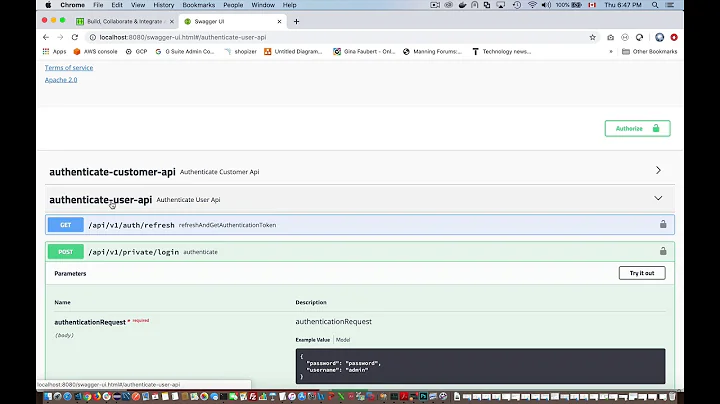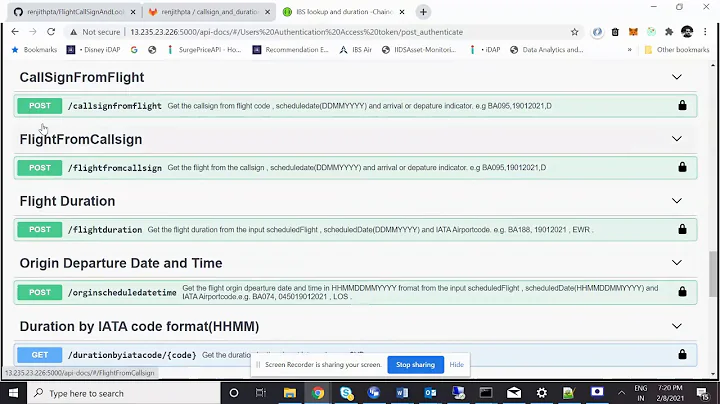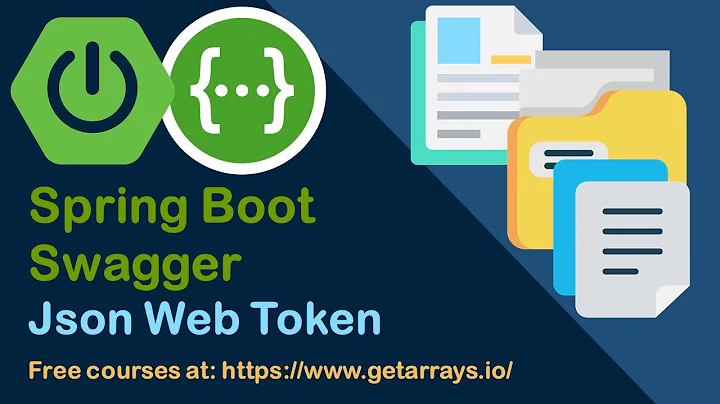How can I represent 'Authorization: Bearer <token>' in a Swagger Spec (swagger.json)
Solution 1
Maybe this can help:
swagger: '2.0'
info:
version: 1.0.0
title: Based on "Basic Auth Example"
description: >
An example for how to use Auth with Swagger.
host: basic-auth-server.herokuapp.com
schemes:
- http
- https
securityDefinitions:
Bearer:
type: apiKey
name: Authorization
in: header
paths:
/:
get:
security:
- Bearer: []
responses:
'200':
description: 'Will send `Authenticated`'
'403':
description: 'You do not have necessary permissions for the resource'
You can copy&paste it out here: http://editor.swagger.io/#/ to check out the results.
There are also several examples in the swagger editor web with more complex security configurations which could help you.
Solution 2
Bearer authentication in OpenAPI 3.0.0
OpenAPI 3.0 now supports Bearer/JWT authentication natively. It's defined like this:
openapi: 3.0.0
...
components:
securitySchemes:
bearerAuth:
type: http
scheme: bearer
bearerFormat: JWT # optional, for documentation purposes only
security:
- bearerAuth: []
This is supported in Swagger UI 3.4.0+ and Swagger Editor 3.1.12+ (again, for OpenAPI 3.0 specs only!).
UI will display the "Authorize" button, which you can click and enter the bearer token (just the token itself, without the "Bearer " prefix). After that, "try it out" requests will be sent with the Authorization: Bearer xxxxxx header.
Adding Authorization header programmatically (Swagger UI 3.x)
If you use Swagger UI and, for some reason, need to add the Authorization header programmatically instead of having the users click "Authorize" and enter the token, you can use the requestInterceptor. This solution is for Swagger UI 3.x; UI 2.x used a different technique.
// index.html
const ui = SwaggerUIBundle({
url: "http://your.server.com/swagger.json",
...
requestInterceptor: (req) => {
req.headers.Authorization = "Bearer xxxxxxx"
return req
}
})
Solution 3
Posting 2022 answer in JSON using openapi 3.0.0:
{
"openapi": "3.0.0",
...
"servers": [
{
"url": "/"
}
],
...
"paths": {
"/skills": {
"put": {
"security": [
{
"bearerAuth": []
}
],
...
},
"components": {
"securitySchemes": {
"bearerAuth": {
"type": "http",
"scheme": "bearer",
"bearerFormat": "JWT"
}
}
}
}
Solution 4
Why "Accepted Answer" works... but it wasn't enough for me
This works in the specification. At least swagger-tools (version 0.10.1) validates it as a valid.
But if you are using other tools like swagger-codegen (version 2.1.6) you will find some difficulties, even if the client generated contains the Authentication definition, like this:
this.authentications = {
'Bearer': {type: 'apiKey', 'in': 'header', name: 'Authorization'}
};
There is no way to pass the token into the header before method(endpoint) is called. Look into this function signature:
this.rootGet = function(callback) { ... }
This means that, I only pass the callback (in other cases query parameters, etc) without a token, which leads to a incorrect build of the request to server.
My alternative
Unfortunately, it's not "pretty" but it works until I get JWT Tokens support on Swagger.
Note: which is being discussed in
- security: add support for Authorization header with Bearer authentication scheme #583
- Extensibility of security definitions? #460
So, it's handle authentication like a standard header. On path object append an header paremeter:
swagger: '2.0'
info:
version: 1.0.0
title: Based on "Basic Auth Example"
description: >
An example for how to use Auth with Swagger.
host: localhost
schemes:
- http
- https
paths:
/:
get:
parameters:
-
name: authorization
in: header
type: string
required: true
responses:
'200':
description: 'Will send `Authenticated`'
'403':
description: 'You do not have necessary permissions for the resource'
This will generate a client with a new parameter on method signature:
this.rootGet = function(authorization, callback) {
// ...
var headerParams = {
'authorization': authorization
};
// ...
}
To use this method in the right way, just pass the "full string"
// 'token' and 'cb' comes from elsewhere
var header = 'Bearer ' + token;
sdk.rootGet(header, cb);
And works.
Solution 5
By using requestInterceptor, it worked for me:
const ui = SwaggerUIBundle({
...
requestInterceptor: (req) => {
req.headers.Authorization = "Bearer " + req.headers.Authorization;
return req;
},
...
});
Related videos on Youtube
Elmer Thomas
Hacker in Residence @SendGrid, Father, Husband, Friend. Learning, so I can teach. Productivity nut, entrepreneur, developer, engineer and lover of APIs & IPAs.
Updated on January 05, 2022Comments
-
Elmer Thomas over 2 years
I am trying to convey that the authentication/security scheme requires setting a header as follows:
Authorization: Bearer <token>This is what I have based on the swagger documentation:
securityDefinitions: APIKey: type: apiKey name: Authorization in: header security: - APIKey: [] -
Rob about 8 yearsI don't see how you tell the editor what user and password or Basic token to send so you can get a 200. Am I missing something?
-
Rob about 8 yearsOK, nevermind. Apparently the "Authenticate" is something you can click on to get a login form.
-
 Gobliins about 8 yearsSo how do i set a value to the token? i tried curl -x get --header "Authorization: apiKey=123" but nothing happened
Gobliins about 8 yearsSo how do i set a value to the token? i tried curl -x get --header "Authorization: apiKey=123" but nothing happened -
Steve K about 8 years@Gobliins you want
curl -X GET -H "Authorization: Bearer your_token", whereyour_tokenis your bearer token. E.g.curl -X GET -H "Accept: application/json" -H "Authorization: Bearer 00000000-0000-0000-0000-000000000000" "http://localhost/secure-endpoint" -
 Gobliins about 8 yearsAh yes thx, but what i dont get is when the connection between the header and the swagger security-definition is happening. Where and when is the validation? I could send this header token just without the security definition at all, where is the use of it?
Gobliins about 8 yearsAh yes thx, but what i dont get is when the connection between the header and the swagger security-definition is happening. Where and when is the validation? I could send this header token just without the security definition at all, where is the use of it? -
Paulo Oliveira almost 8 years@david-lopez have you tried to generate a SDK by swagger-codegen with these Security Definitions? Because while Swagger 2.0 Specification accepts these YAML and validates it. Swagger-codegen v2.1.6 generates an SDK without anyway possible to
tokeninto the function and appends to Authorization header. Mostly because specification and related not support JWT (Authorization Header) natively. -
Abe Voelker almost 6 yearsUnfortunately this doesn't work well with Swagger UI - clicking "Authorize" and providing a bare token will generate "Try it out" curl examples with
-H "Authorization: foo"instead of-H "Authorization: Bearer foo"like the OpenAPI 3 answer -
Chang Zhao over 5 yearsHow do I implement this in flask-restplus generated swagger documentation ?
-
seawave_23 almost 5 years"token comes from elsewhere"... I'm interested in the elsewhere. What when you logged got directed to your login and redirected to your swagger api, how can you use the access token you received?
-
 Vishrant almost 5 yearsI doubt if answer aligns with the question that was asked.
Vishrant almost 5 yearsI doubt if answer aligns with the question that was asked. -
 Naren over 3 yearsWorked like a charm :-))
Naren over 3 yearsWorked like a charm :-)) -
 csteel over 3 yearsWorkaround for me was to put Bearer xxxxxxxx as the key in the UI authorization box. This worked, though the drawback is telling users to manually enter Bearer and then the key. Alternatively, you can modify your function/method for returning the API key to included the Bearer prefix as part of the key.
csteel over 3 yearsWorkaround for me was to put Bearer xxxxxxxx as the key in the UI authorization box. This worked, though the drawback is telling users to manually enter Bearer and then the key. Alternatively, you can modify your function/method for returning the API key to included the Bearer prefix as part of the key. -
 Humayun Naseer about 3 yearsby doing this im getting no routes matches error
Humayun Naseer about 3 yearsby doing this im getting no routes matches error -
 Kakash1hatake about 2 yearsWhile reading swagger docs I can't get where the token endpoint in this scheme is
Kakash1hatake about 2 yearsWhile reading swagger docs I can't get where the token endpoint in this scheme is










